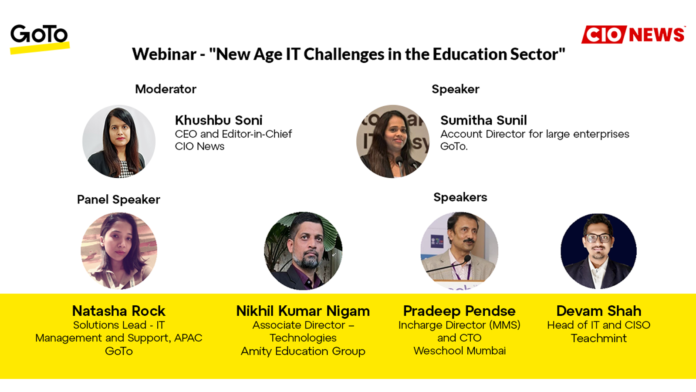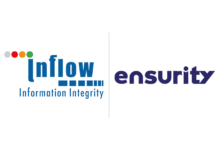CIONews and GoTo recently hosted a webinar that brought together notable experts from the field of education to analyse the emerging challenges faced by the education sector and the role of robust IT management in tackling them.
Education is a crucial pathway for individuals to acquire necessary skills for life-long success. In an age that’s increasingly becoming digital by the day, the education sector had to keep up with the pace of technological changes. Especially since the pandemic, the education sector has embraced a paradigm shift of operating off the grid like never before. Online courses, remote/hybrid learning, teacher preparation programs have become essential tools, driving the sector towards a complete digital transformation. However, this transition has not been without its challenges.
CIONews and GoTo recently hosted a webinar that brought together notable experts from the field of education to analyse the emerging challenges faced by the education sector and the role of robust IT management in tackling them. The panel included Nikhil Kumar Nigam, Associate Director Technologies of Amity Education Group; Pradeep Pendse, in-charge Director and CTO of Weschool Mumbai; Devam Shah, Head IT CISO of Teachmint and Natasha Rock, Solutions Lead, IT Management and Support of GoTo, APAC. The panel was moderated by Khushbu Soni, CEO and Editor-in-Chief of CIONews and ended with insights from Sumitha Sunil, Account Director for large enterprises at GoTo. The webinar highlighted the transformative role of innovative IT solutions in overcoming these hurdles and shaping the future of education.
Breaking barriers: Unveiling the challenges that is hindering equal access in remote learning
The webinar kick-started with an intriguing poll question asking the audience to identify primary hurdles in achieving equitable access to technology and resources for remote learning. Technological literacy among students and teachers emerged as the top concern, with 45% of respondents identifying it as a significant obstacle. Tailoring content to cater to diverse learning needs closely followed, garnering the attention of 43% of participants. The availability of devices and internet connectivity ranked high on the list, with 40% recognising it as a critical challenge. 36% identified access to the right tools to support remote learning as a major hurdle, while 21% said financial constraints faced by educational institutions were a significant impediment.
When it comes to remote/hybrid learning, reliable connectivity and flexibility is of paramount importance. Devam Shah from Teachmint highlighted the potential of 5G and metaverse in enhancing hybrid learning experience. The use of remote support technology, a field that GoTo has pioneered, has increased significantly to bridge the accessibility gap and help teachers and students to operate remotely with ease, from any part of the country. Nikhil Kumar Nigam emphasised IoT’s role in enhancing online learning, management systems, and library functions. As digitalisation rapidly transforms the education landscape, staying updated with the latest advancements is crucial for educators and administrators.
The panel underscored the need for operational efficiency, robust network infrastructure and reliable connectivity to facilitate seamless online education. Panelists emphasised investing in high-speed internet access and secure platforms as key to bridging the digital divide.
Safeguarding sensitive student data: A priority in remote learning
The webinar delved into the critical aspects of data security and privacy, acknowledging the growing reliance of educational institutions on technology for storing and managing sensitive student information. Establishing robust data security measures is imperative to protect this data. To address this concern, survey continued with a second poll question: “What cybersecurity concerns pose the greatest threat to educational institutions?”
The results revealed that 68% of respondents considered insider threats and unauthorised access to be the most significant concerns. Data breaches and information leaks followed closely at 60%, while phishing attacks, social engineering, and ransomware malware infections were also identified as major threats. Shah shed light on the prevalence of phishing and social engineering attacks in the primary education sector, where children may struggle to discern the authenticity of messages sent by attackers via email. Pradeep Pendse also suggested potential solution and authentication measures such as machine binding to websites.
Protecting student data and maintaining privacy should remain a top priority for educational institutions. Attendees gained valuable insights into best security practices as the panelists delved into the available technologies for safeguarding sensitive student information and ensuring compliance with regulations.
Revolutionising education: Navigating digital integration and overcoming obstacles
The last segment shed light on the adoption and integration of new digital solutions in educational institutions. While the attendees revealed their common hurdles of aligning with existing infrastructure and upskilling staff, the panel unanimously emphasised the pivotal roles of user-friendly design and cutting-edge technology in driving digital adoption. They stressed the importance of meticulous design, compatibility with current systems, and comprehensive training.
Collectively, multiple factors have to be taken into consideration while digitalising an educational infrastructure, including security, background monitoring and support, and remote assistance. These are key drivers necessitating the tracking and monitoring of student and teacher interactions. Natasha Rock from GoTo stressed the importance of extending this vigilance to mobile device management, considering the rising use of mobile devices in online learning.
Experts further explored the ethical considerations and responsible use of technology in education, highlighting its potential to overcome challenges for students and faculty. Later, Sumitha Sunil shared a glimpse of GoTo and its product portfolio, underscoring their role in creating cutting-edge IT solutions to support the education sector.
Tech takes the lead: Revolutionising education through innovative solutions
GoTo and CIONews’ collaborative webinar on “New Age IT Challenges in the Education Sector” revealed technology’s game-changing role in education. It addressed hybrid learning challenges, focusing on innovative IT solutions that can facilitate better accessibility and efficient connection and communication between learners and teachers. The webinar showcased the potential of 5G, metaverse, and IoT in enhancing remote learning. Data security and privacy took center stage, while integration challenges and the need for user-friendly designs were highlighted. The driving factors for tech adoption and ethical implications were explored, including promoting collaboration and offering greater accessibility. In today’s tech-driven world, it is most important for the education sector to not only to catch up but also make smart technology choices that seamlessly and flexibly enable student-teacher interaction and help learners thrive to become the future generation of geniuses.
Also read: Unleashing the Power of Machine Learning – Implementation and Implications
Do Follow: CIO News LinkedIn Account | CIO News Facebook | CIO News Youtube | CIO News Twitter
About us:
CIO News, a proprietary of Mercadeo, produces award-winning content and resources for IT leaders across any industry through print articles and recorded video interviews on topics in the technology sector such as Digital Transformation, Artificial Intelligence (AI), Machine Learning (ML), Cloud, Robotics, Cyber-security, Data, Analytics, SOC, SASE, among other technology topics






